Author: Sharon Jang | Reviewer: Emma M. Smith | Published: 25 May 2020 | Updated: ~
Wheeled mobility devices like wheelchairs and scooters are an important part of independent living after spinal cord injury (SCI). This page provides an overview of the basics of wheelchair seating after SCI.
Key Points
- Wheelchair seating includes parts of the wheelchair that help you maintain a proper and comfortable posture when seated. This includes the backrest, foot rests, and cushion.
- Proper wheelchair seating is important to prevent pressure sores, maintain posture, and promote function.
- There are many different types of seating cushion, each with its own benefits and drawbacks.
- There are three main aspects of backrests to be considered when getting fitted to a wheelchair: the height, the shape, and the stiffness.
A wheelchair seating assessment is a complex process where healthcare professionals assess your body and fit you to a wheelchair to suit your needs. How you fit in your wheelchair can significantly impact your health and comfort while using your device. A proper seating assessment can be used to prevent conditions (for example, spine deformation) from getting worse, to correct posture, and to accommodate for other aspects that are not changeable. The seating process is done in combination with other rehabilitation interventions (such as exercises, physical therapy, and spasticity management), and should be done with specific therapeutic goals in mind.
In this document, we will focus on the components on seating. Seating components consist of backrests, cushions, and accessories (e.g., footrests and arm rests). Having appropriate seating is important to having good posture while in your wheelchair, being able to function while using the wheelchair, and maintaining good skin health.
Refer to our article on Wheelchair Provision for more information!
Pressure sores
As you may be spending the majority of your time in your wheelchair, sitting pressures are of concern to skin health. Research (moderate evidence) has suggested that the sitting postures of individuals with SCI are different than able-bodied individuals. In the SCI population, higher sitting pressures are exhibited. Up to half of pressure ulcers occur on the sit bones, and are likely to have developed when sitting. Having a proper cushion suited to the way you sit can help to prevent pressure sores by redistributing pressure.
Maintaining posture
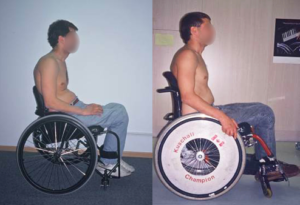
Your wheelchair setup can have a major effect on your posture while seated.1
The way your wheelchair is set up can impact your sitting posture. After an SCI, you may not be able to control the stability of your trunk, which can lead to spinal deformities and abnormal sitting positions. However, the use of a proper cushion and supports can help address sitting posture. For example, one study (weak evidence) suggests that the use of lateral supports (i.e., pads supporting the side to prevent side to side leaning) can help improve the alignment of the spine and to help improve posture while reducing the amount of effort required by muscles for postural control.
Psychosocial concerns
The way you are able to present yourself while sitting in your wheelchair may impact your psychosocial health, or your sense of confidence and self-esteem.
Quality of life
Having proper seating may impact your quality of life. Good seating can allow you to fully participate in leisure activities, and may allow you to go to school or to work. These activities depend on your sitting tolerance (how long you are able to sit in your chair comfortably) and your ability to effectively travel in your wheelchair.
There are two main purposes of wheelchair cushions: 1) to help improve function and achieve a balanced posture, and 2) to redistribute the pressure applied by the sit bones when seated. Taken together, the cushion can impact the amount of support provided, which in turn determines how long someone can sit for, how easily transfers can be done, and posture of the hips. There are many types of cushions available on the market, as no one cushion is suitable for all individuals with SCI. To determine which is best suited for your needs, various factors are considered, including:
- The amount of pressure reduction/redistribution required
- Temperature effects (warm temperatures may lead to sweating, which may make the skin more vulnerable to injury and infections)
- Your level of injury
- Your ability to relieve pressure off your sit bones
- Your transfer techniques
- Your lifestyle
Although new cushions may be able to provide support and redistribute pressure applied by the sit bones, the effectiveness of a cushion decreases over time. Some research studies have looked into factors that impact deterioration of a cushion. Weak evidence suggests that how a cushion is used is a bigger indicator of deterioration compared to age of the cushion. For example, factors such as how you transfer in and out of your wheelchair, frequency of curb jumps or high vibration activities, exposure to the elements (rain, snow, etc.), moisture, and exposure to extreme temperatures can negatively impact the quality of your cushion.

When sitting, pressures are created (orange) from the force of your sit bones on your buttock.2

During offloading, a greater surface area of the buttock is in touch with the cushion.3
Pressure sores develop when there is a lot of pressure applied at one point. We can counter this focussed pressure through pressure redistribution, i.e. spreading out the sitting pressures. This can be done in three ways: offloading, immersion, and immersion and envelopment.
When offloading, pressure is distributed over a greater surface area. To achieve this, pressure is distributed over the majority of the buttock (i.e., more of the buttock is in contact with the cushion) rather than just on the sit bones (see top right image). To encourage this position, a piece of the cushion may be taken out so there is a grooved surface.

Immersion and envelopment is a combination of sinking into the cushion and having the cushion form to the shape of your buttock.5

During immersion, the buttock sinks into the cushion.4
Immersion refers to a property of the cushion material, which allows the body to “sink” into it. Given the material’s ability to be compressed, pressure is redistributed by increasing the amount of body surface area that is in contact with the cushion.
Immersion and envelopment redistributes pressure by allowing the body to sink into the material, while the material conforms to the body’s shape. This maximizes pressure distribution by increasing the amount of surface area in contact with the cushion.
There are five common types of cushion material: foam, gel, air, honeycomb urethane, and alternating pressure.
Foam cushions
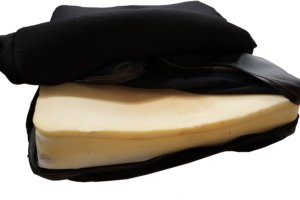
Foam cushions require protection from getting wet. The cushion above features an extra lining under the cushion cover to help keep it dry.6
Foam cushions are a cheaper option, and come in a variety of densities, ranging from soft memory foam to higher density foam. Foam is able to adapt to shapes, is low maintenance, and can provide support while spreading sitting pressures. One downside to using foam is that it wears out and loses its shape quickly. In addition, foam cushions are only able to provide a limited amount of pressure relief and comfort. Foam cushions also must be protected from getting wet. The use of foam cushions is recommended for those with basic sitting needs.
Gel cushions
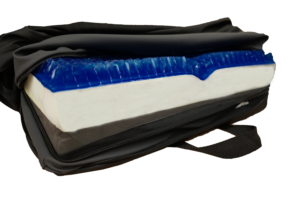
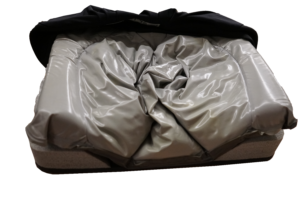
A variety of gel cushions exist. These include a gel matrix (left) and a gel cushion (right).7
There are different types of gel cushions including gel matrix and gel cushions. Gel cushions aim to provide seating comfort by using gel placed on top of a layer of supportive foam. Gel cushions are able to relieve pressure points and distribute pressure over a larger area, while providing a stable surface to support positioning. They may also help counter effects of high temperatures with its cooling properties. Some drawbacks to using a gel cushion include heavier weight and a lack of shock absorption. Gel cushions also have the potential to “bottom out” (when all the gel is pushed aside, massaging may be required to redistribute the gel), and a potential for leaks.
Air cushions
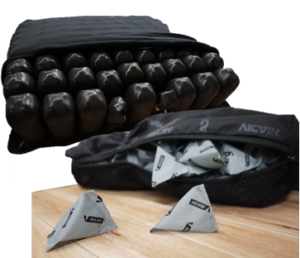
Air cushions are often comprised of a group of small air-filled cells. In some air cushions, the cells are interconnected, while other versions contain multiple separate air sacs contained within a cushion cover. These cells support the weight of the user, and spread out the pressure of sitting through shifting air to the surrounding cells. These cushions are customizable in regards to the number of cells and the amount of air each cell is able to hold. If the cells are interconnected, the amount of air in the cushions can be adjusted using a pump. Moderate evidence has suggested that the use of air cushions can reduce the risk of a pressure sore through reducing the amount of pressure produced while sitting and promotion of air flow. Furthermore, air cushions are generally waterproof. Although these cushions are great for providing pressure distribution, they are not optimal for stability and postural support. In addition, they may be considered high maintenance as the pressure of the cushion has to be checked frequently and manual pumping of air into the cushion is required.
Honeycomb urethane cushions
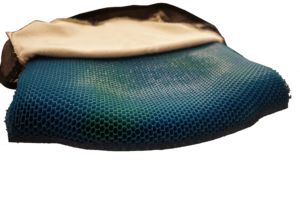 These light-weight durable cushions resemble a honeycomb in that they are composed of multiple open cells. These cells are able to distribute pressure evenly while avoiding the risk of being punctured. Air flow is also promoted throughout the open cells to prevent skin breakdown. As these cushions are made out of urethane, a material that resembles rubber, they also provide good shock absorbance. However, compared to other cushions, they provide moderate positioning capabilities and are not modifiable in shape.
These light-weight durable cushions resemble a honeycomb in that they are composed of multiple open cells. These cells are able to distribute pressure evenly while avoiding the risk of being punctured. Air flow is also promoted throughout the open cells to prevent skin breakdown. As these cushions are made out of urethane, a material that resembles rubber, they also provide good shock absorbance. However, compared to other cushions, they provide moderate positioning capabilities and are not modifiable in shape.
Alternating pressure cushions
Alternating pressure cushions consist of multiple air bladders (similar to an air cushion) with an added battery-operated microprocessor that controls the amount of air in each part of the cushion. Every 4-6 minutes, the air in each segment of the cushion alternates (i.e., inflates or deflates) to help relieve pressure of the users’ bottom. This cushion is suitable for individuals who are unable to effectively relieve seated pressure. There has been weak evidence suggesting that alternating pressure cushions have provide good user satisfaction and comfort. Some negatives for this cushion include its high cost, heavy weight (as it requires a pump and a motor), and susceptibility to punctures.
While cushion marketing may promote a reduction in sitting pressure, more research is required to determine whether reducing the pressure on the sit bones or decreasing risk factors will prevent pressure ulcers. Pressure mapping is one technique that may be used to help determine the areas that are prone to pressure sore.
Refer to our article on Pressure Mapping for more information!
Custom Contour CushionsThese cushions are made custom to the shape of your buttock in an attempt to reduce pressure. Often, custom contour cushions are made with a combination of the aforementioned materials, accounting for the high pressure areas identified by pressure mapping. There is moderate research evidence that suggests that custom contoured cushions may create a safe sitting surface for individuals with SCI through the ability to redistribute sitting pressures. There is also weak evidence that using a custom contour cushion may help increase sitting stability and posture. If using a custom contour cushion, avoid getting the cushion wet as it may deform, and be careful to properly position yourself on the cushion as there is only one position that is optimal for comfort and pressure distribution. |
The main purposes of backrests are to provide stability and support to the trunk and the hips. Backrests are adjustable in three different ways: the height, the shape, and the stiffness.
Height
For manual wheelchair users, the height of the backrest can vary. Low backrests provide support for the lower back, and are often preferred by active users as they allow for more mobility in the upper spine. However, the use of a low backrest requires complete or partial trunk control, as it does not provide much stability. Higher backrests typically span the majority of the back, but should come up to just under the shoulder blades. A higher back rest can provide more support, but a backrest that is too high may hinder mobility.
There has been some research on the impact of various backrest heights on the range of motion required for propulsion and reaching/grasping motions. One study (weak evidence) has shown that the height of the backrest may influence the efficiency of pushing a manual wheelchair. In particular, the authors suggest that a low back rest may be more beneficial for wheelchair propulsion, as it allows for greater movement in the shoulder, a greater push rate (i.e., more pushes per minute), and a greater propulsion stroke. In addition, a lower back rest has been found to allow paraplegics to apply more force when propelling their wheelchairs. However, with regards to reaching, a (weak evidence) study found that backrest height did not have an effect.
As power wheelchair users do not need to manually propel their wheelchair, the height of the backrest is typically higher. These backrests typically span the entire length of the back, and provide more support to the spine. Moreover, having a taller backrest can provide a resting position for tilt or recline functions.
Shape
Backrests generally come in three different shapes: flat, general contour, and custom contoured.
Flat backrests
 Flat backrests are flat or slightly curved in shape, and often consist of a stiff flat surface (e.g., plastic, plywood) that is layered with foam and covered with material. This style of back allows for the greatest range of motion of the arms, thus creating increased freedom. Another advantage of the flat backrest is that it is very adjustable and can accommodate a large variety of support accessories, such as lateral supports, chest straps, and headrests. A drawback to this style of back is that it provides limited support. It does not accommodate for the shape of the spine, making it less suitable for individuals with lordosis (i.e., sway back) or kyphosis (i.e., a hunched back).
Flat backrests are flat or slightly curved in shape, and often consist of a stiff flat surface (e.g., plastic, plywood) that is layered with foam and covered with material. This style of back allows for the greatest range of motion of the arms, thus creating increased freedom. Another advantage of the flat backrest is that it is very adjustable and can accommodate a large variety of support accessories, such as lateral supports, chest straps, and headrests. A drawback to this style of back is that it provides limited support. It does not accommodate for the shape of the spine, making it less suitable for individuals with lordosis (i.e., sway back) or kyphosis (i.e., a hunched back).
General contoured backrests
 General contoured backrests are off-the-shelf backs that are shaped, but are not customized to your back. These backs provide more support than a flat back, as they have a deeper contour that can provide lateral (side) support. The effectiveness of general contoured backs is based on how well the back fits your needs; they may only be effective if you can find one that suits your needs.
General contoured backrests are off-the-shelf backs that are shaped, but are not customized to your back. These backs provide more support than a flat back, as they have a deeper contour that can provide lateral (side) support. The effectiveness of general contoured backs is based on how well the back fits your needs; they may only be effective if you can find one that suits your needs.
Custom contoured backs
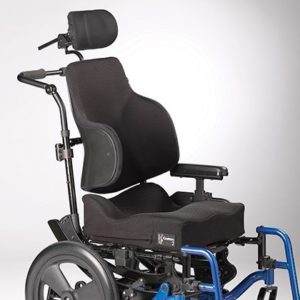 Custom contoured backs provide increased support for positioning, and are made custom to the shape of your back. This cushion is often used if you require extra positioning support, and if the general control back or flat back does not meet your needs. The creation of custom contour backs can be a lengthy and costly labour-intensive process. When creating a custom contour back, a mold of your back is taken. A seating specialist then inspects the mold to ensure that it is reflective of the shape of your back and that the contour information is accurate. The backrest is then carefully made to the specifications obtained from the measuring process. As custom contour backs are designed to fit the shape of your back to provide more support, they also impose limitations on flexibility. When transferring in and out of your wheelchair, it is also important to be properly aligned in your custom contoured backrest, as improper fitting may lead to pressure sores or skin breakdown.
Custom contoured backs provide increased support for positioning, and are made custom to the shape of your back. This cushion is often used if you require extra positioning support, and if the general control back or flat back does not meet your needs. The creation of custom contour backs can be a lengthy and costly labour-intensive process. When creating a custom contour back, a mold of your back is taken. A seating specialist then inspects the mold to ensure that it is reflective of the shape of your back and that the contour information is accurate. The backrest is then carefully made to the specifications obtained from the measuring process. As custom contour backs are designed to fit the shape of your back to provide more support, they also impose limitations on flexibility. When transferring in and out of your wheelchair, it is also important to be properly aligned in your custom contoured backrest, as improper fitting may lead to pressure sores or skin breakdown.
Stiffness
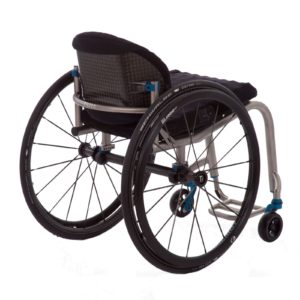
A rigid back on a manual wheelchair.13

Soft backs are often found on folding manual wheelchairs.14
The stiffness of wheelchair backs are either soft or rigid. Soft backs (i.e., sling backs) are able to accommodate to the shape of the spine and can be effective if they are properly adjusted. However, they provide less support compared to rigid backs and can stretch over time depending on the fabric. Tension adjustable backs consist of interwoven straps that can be tightened or loosened to accommodate for posture. One weak study found that the use of a tension adjustable back provides more support than a normal sling back. While it provides more support for the hips, it may still result in poor posture. Rigid backs generally provide more support and can help with stability. However, rigid backs are less adjustable, and do not accommodate for the shape of the spine. Although rigid backs may be more supportive, weak evidence has suggested that rigid backs are less comfortable than sling backs among individuals with tetraplegia.
Footrests (or leg rests) are an important part of a wheelchair. They function to stabilize your legs for optimal hip and back posture, help promote redistribution of sitting pressures, and may promote circulation. Footrests come in a variety of options. Footrests may be fixed (as one plate or two), swing-away (i.e., can be moved away from the front or removed), or flip up (particularly in powered wheelchairs). Elevating footrests allow for the leg to be in a raised position, which may help alleviate some leg pain.
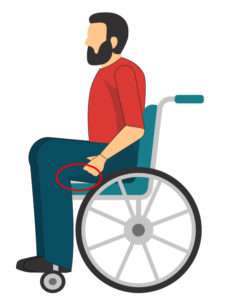
Having a foot rest that is too high may result in more pressure on your buttock.15
The length of the footrest hanger (i.e., the distance from the back of the knee to the heel) can impact how you are seated in the wheelchair. Having a footrest that is too short will push your knees upward, so that the bottom of your thighs are no longer in contact with the top of the seat cushion. As a result, more pressure is applied to your sit bones and there is a lessened ability to shift your weight backward if you slide forward. On the other hand, a footrest that is too long may result in sliding forward in the wheelchair. Consequently, someone with a footrest that is too long may tend to slide forward often in their chair, leading to a hunched back.
Some weak evidence suggests that footrests can affect how activities of daily living are performed, but not the types of activities performed. The use of footrest may help improve the sitting balance of individuals with a lumbar SCI, but not those with a thoracic SCI.
Arm rests on wheelchairs serve multiple purposes and offer more benefits than simply acting as a place to rest the arms. In addition to acting as an arm rest, this part is also used to help maintain posture, redistribute pressure, and to enhance functioning (e.g., transfers, stability). The benefit of using armrests is dependent on an individual’s level of injury and abilities. An individual with more control of their torso and arms will be less likely to need armrests. Some active individuals tend to find that arm rests get in the way.
Maintaining posture
 Using armrests can help maintain a good seated posture for an individual using a wheelchair. By supporting the arms and forearms, weight is alleviated from the shoulders. Without armrests, the weight of your arms may pull your shoulder down, resulting in a hunched position. It is also important that your armrests are set to an appropriate height. Armrests that are too low may require the individual to lean forward to use the armrest, which may lead to hunching. If the armrests are too high, the shoulders may be pushed up too high, which can lead to discomfort.
Using armrests can help maintain a good seated posture for an individual using a wheelchair. By supporting the arms and forearms, weight is alleviated from the shoulders. Without armrests, the weight of your arms may pull your shoulder down, resulting in a hunched position. It is also important that your armrests are set to an appropriate height. Armrests that are too low may require the individual to lean forward to use the armrest, which may lead to hunching. If the armrests are too high, the shoulders may be pushed up too high, which can lead to discomfort.
Redistributing pressure
 Armrests can act as a source of support for repositioning to alleviate pressure on the sit bones. Weak evidence suggests that individuals with paraplegia rely on armrests more than tetraplegics during weight shifting (9% of their body weight vs 5%). The researchers think that this may be the case because individuals with tetraplegia have weak arm extensor muscles, making weight relieving difficult. In addition to acting as a support to push off from, armrests can also help alleviate pressure on the sit bones by supporting the weight of your arms. By removing the weight of hanging arms, the hips are unloaded and pressure forces are redistributed.
Armrests can act as a source of support for repositioning to alleviate pressure on the sit bones. Weak evidence suggests that individuals with paraplegia rely on armrests more than tetraplegics during weight shifting (9% of their body weight vs 5%). The researchers think that this may be the case because individuals with tetraplegia have weak arm extensor muscles, making weight relieving difficult. In addition to acting as a support to push off from, armrests can also help alleviate pressure on the sit bones by supporting the weight of your arms. By removing the weight of hanging arms, the hips are unloaded and pressure forces are redistributed.
Enhancing function
Armrests can be helpful for everyday activities such as transferring, picking up objects, and stability. When transferring, the armrests act as a source of support and are used to push up and off from, or they can be a firm object to hang onto when transferring back in. In addition, armrests may act as a source of stability when completing tasks that may challenge someone’s balance, such as picking up objects off the ground, reaching for high objects, and leaning.
There are a variety of seating accessories that can be used to optimize comfort and posture. Although accessories can be used to enhance your seating, the majority of your posture should be supported through your seating set up (i.e., the backrest, cushion, foot rest), and not through accessories.
Upper extremity accessories
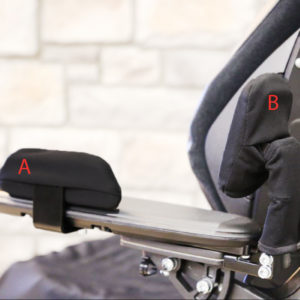
Arm supports to prevent the arm from falling off the side (A) and the elbow from sliding back (B).18
Seating accessories for the arms are more often found on power wheelchairs than manual wheelchairs. This group of accessories include armrest side supports and elbow blocks. Armrest side supports help prevent the forearm from falling off the side of the wheelchair, while elbow blocks prevent your elbows from sliding backwards. The use of these accessories can help keep your arm in place, especially when driving over rough terrain, and can help with repositioning.
Lower extremity support accessories
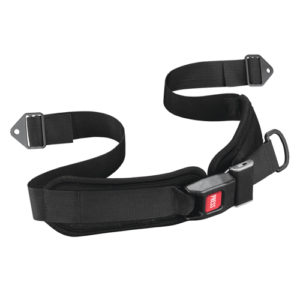
A two-point seatbelt (left) and a four-point seatbelt (right).19-20
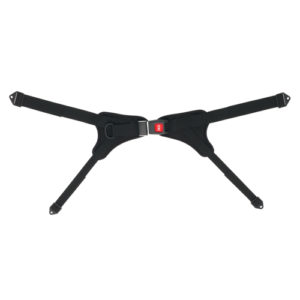 Various accessories are available to help support and position all parts of the lower limb including: the hips and buttock, knees, lower legs, and feet. To support the hips and the buttock, positioning belts (sometimes referred to as seat belts) can be used. When used on wheelchairs, positioning belts can help prevent the hips from sliding forward and help to keep the hips properly aligned (i.e., not tilted or rotated). Different types of positioning belts are available depending on your needs: two-point belts or four-point belts. Four-point belts offer more support to the hips if required. It is also important to note that safety belts are not the same as positioning belts. Although both may contribute towards safety, positioning belts are more specialized to help maintain your hip posture.
Various accessories are available to help support and position all parts of the lower limb including: the hips and buttock, knees, lower legs, and feet. To support the hips and the buttock, positioning belts (sometimes referred to as seat belts) can be used. When used on wheelchairs, positioning belts can help prevent the hips from sliding forward and help to keep the hips properly aligned (i.e., not tilted or rotated). Different types of positioning belts are available depending on your needs: two-point belts or four-point belts. Four-point belts offer more support to the hips if required. It is also important to note that safety belts are not the same as positioning belts. Although both may contribute towards safety, positioning belts are more specialized to help maintain your hip posture.
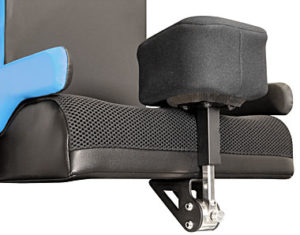
A pommel connected to the wheelchair.21
There are also an assortment of accessories to address knees that press inward, splay outward, or are windswept. To address knees that press inward, pommels are cushions mounted either to the wheelchair or cushion, which go between the knees to keep them separated; however, pommels that are too big may interfere with transferring. To address knees that splay outward, adductor pads can be used. These pads are placed on the outer edges of the wheelchair cushion, which support the thigh and prevent the knees from falling outward.
Some accessories for the feet and lower leg include strapping and pads. Heel and toe straps can be connected to the footplate to help prevent the foot from moving forward or backward. After SCI, this can be particularly useful to help manage tone in the lower legs, and ensure the person remains stable in their wheelchair. To support the calves, pads can be attached to the footrest. Calf pads are particularly used with power wheelchairs, as they can provide support to the calves during tilting or reclining.
Trunk Support

Lateral supports on a power wheelchair, circled in red.22
Lateral supports, straps, or upper body positioning belts are used by individuals who have difficulty maintaining an upright posture that may be caused by muscle weakness or other conditions. Lateral supports are square or rectangular pads that connect to the back of the wheelchair and rest against the trunk to promote balance and stability. Moreover, the lateral pads can also act as a clear indicator that you are out of alignment (e.g., when you notice you are heavily leaning on a lateral support, try to consciously correct your posture if possible). Chest supports, including chest straps, can help prevent tipping forward due to weakness in the abdominal and back muscles. When used properly, accessories can help with trunk support, stability, balance, and posture. Correct positioning and support of the trunk may prevent further progression of some spinal conditions, such as scoliosis. If placed incorrectly, these supports may be ineffective. For example, if they are placed too low they may not provide the support needed, while if they are placed too high they may irritate your shoulder, the nerves in your arm, or limit arm movement. When changing sitting positions, ensure to also readjust your trunk supports as they may shift as well.
Wheelchair seating is a complex procedure which includes multiple assessments by healthcare professionals to ensure that your wheelchair is best suited for your needs. Given that the majority of your day may be spent in a wheelchair, it is important to consider ways to relieve sitting pressures and to maintain your postures. To do so, some parts of your wheelchair that may be customized include the cushion, back, and leg rests. It is best to discuss all treatment options with your health providers to find out which treatments are suitable for you.
For a review of how we assess evidence at SCIRE Community and advice on making decisions, please see SCIRE Community Evidence.
SCIRE Community. “Powered Mobility Devices”. Available from: https://community.scireproject.com/topic/powered-mobility/
SCIRE Community. “Manual Wheelchairs”. Available from: https://community.scireproject.com/topic/manual-wheelchairs/
SCIRE Community. “Wheeled mobility video series”. Available from: https://community.scireproject.com/videos/wheeled-mobility/
Titus L, Moir S, Casalino A, McIntyre A, Connolly S, Mortenson B, Guilbalt L, Miles S, Trenholm K, Benton B, Regan M. (2016). Wheeled Mobility and Seating Equipment Following Spinal Cord Injury. In Eng JJ, Teasell RW, Miller WC, Wolfe DL, Townson AF, Hsieh JTC, Connolly SJ, Loh E, McIntyre A, editors. Spinal Cord Injury Rehabilitation Evidence. Version 6.0: p 1-178.
Available from: scireproject.com/evidence/wheeled-mobility-and-seating-equipment/
Evidence for “Why is proper seating important” is based on:
Bogie K, Wang X, Fei B, Sun J. New technique for real-time interface pressure analysis: Getting more out of large image data sets. Journal of rehabilitation and research development, 45, 5236.
Mao HF, Huang SL, Lu TW, Lin YS, Liu HM, Wang YH, et al. Effects of lateral trunk support on scoliotic spinal alignment in persons with spinal cord injury: a radiographic study. Archives of Physical Medicine and Rehabilitation, 87, 764-71.
Thomson, D., Tully, P., Blochlinger, S. (n.d.). Laying the foundation for proper positioning: introduction to positioning for functional ability and wheelchair seating. [Powerpoint]. Retrieved from: https://seatingsymposium.com/images/pdf/PS/PS2_Tully_Thomson_Blochlinger.pdf
Evidence for “Why are cushions important” is based on:
Sprigle, S. (2014). Measure it: proper wheelchair fit is key to ensuring function while protecting skin integrity. Advanced wound skin care, 27, 561-72.
Sprigle S, Delaune W. (2014) Factors That Influence Changes in Wheelchair Cushion Performance Over Time. Assistive Technology, 26, 61-68.
Evidence for “How can a cushion redistribute pressure” is based on:
Endsjo, A., Mullis, S, Sharpe, L. 2019. Wheelchair seating and positioning guide. Retrieved from: https://hub.permobil.com/wheelchair-seating-positioning-guide
Evidence for “What kinds of cushions are there” is based on:
Sprigle S, Chung KC, Brubaker CE. (1990) Reduction of sitting pressures with custom contoured cushions. Journal of rehabilitation research and development, 27, 135-40.
Stewart, D. (2019). Comfort wheelchair cushions. Retrieved from: https://mobilitybasics.ca/seating/basic
Stewart, D. (2019). Comfort wheelchair cushions. Retrieved from: https://mobilitybasics.ca/seating/basic
Wheelchair seat cushions. (2019). Retrieved from: https://www.wheelchair-works.com/wheelchair-seat-cushion.html
Waugh, K. (2014). Custom contoured seating: Ensuring Successful Outcomes. [Powerpoint slides]. Retrieved from: https://seatingsymposium.com/images/pdf/PS/PS3_Waugh.pdf
Evidence for “Backrest” is based on:
Fontein, J. (2017). What’s in a back? [Abstract]. Canadian seating and mobility conference.
Hong EK, Dicianno BE, Pearlman J, Cooper R, Cooper RA. (2016). Comfort and stability of wheelchair backrests according to the TAWC (tool for assessing wheelchair discomfort). Disability and Rehabilitation: Assistive Technology, 11, 223-227.
Samuelsson K., Bjork, M., Erdugan, A.M., Hansson, A.K., Rustner, B. (2009). The effect of shaped wheelchair cushion and lumbar supports on under-seat pressure, comfort, and pelvic rotation. Disability and rehabilitation: assistive technology, 4, 329-336.
Schmeler, M.R., Buning, M.E. (1999). Wheelchair back supports. [Powerpoint slides]. Retrieved from: https://www.wheelchairnet.org/WCN_WCU/SlideLectures/MS/4SeatBacks.pdf
Yang YS, Koontz AM, Yeh SJ, Chang JJ. (2012). Effect of backrest height on wheelchair propulsion biomechanics for level and uphill conditions. Archives of physical medicine and rehabilitation, 93, 654-659.
Evidence for “Footrest” is based on:
Janssen-Potten YJ, Seelen HA, Drukker J, Spaans F, Drost MR. The effect of footrests on sitting balance in paraplegic subjects. Archives of Physical Medicine and Rehabilitation, 83, 642-8.
Sprigle, S. (2014). Measure it: proper wheelchair fit is key to ensuring function while protecting skin integrity. Advanced wound skin care, 27, 561-72.
Evidence for ” What accessories are used for seating?” is based on:
Stewart, D. (2019). Wheelchair seating products – accessories. Retrieved from: https://mobilitybasics.ca/seating/accessories
Image credits
- Wheelchair Posture. ©Shannon Sproule
- Sitting pressures. ©The SCIRE Community Team
- Offloading pressures ©The SCIRE Community Team
- Immersion ©The SCIRE Community Team
- Immersion and Envelopment ©The SCIRE Community Team
- Foam cushion ©The SCIRE Community Team
- Gel cushions ©The SCIRE Community Team
- Air cushions ©The SCIRE Community Team
- Honeycomb Cushion ©The SCIRE Community Team
- Jay basic back ©Sunrise Medical 2017
- Jay J2 Series Back ©Sunrise Medical 2017
- Ride designs custom 2 cushion ©Action Seating and Mobility
- ZR Back Right Product Detail ©Permobil 2020
- Wheelchair. ©George Hodan. CC0 1.0
- Modified from Disabled people set ©macrovector Freepik License
- Polio Wheelchair Lady ©jackcast2015, CC BY 2.0
- This was one of five images (PHIL #9170-9174), depicting the action of two different mobility-challenged women getting into a bathtub ©Richard Duncan, Public Domain
- Permobil original elbow & armrest side supports ©Permobil, 2020
- Hip belt, push button, 1” webbing, center pull, 6” pads. ©Adaptive Engineering Lab (AEL) 2015
- Hip stabilizing belt, push button, rear pull, large. ©Adaptive Engineering Lab (AEL) 2015
- Heavy duty flipdown abductor hardware. ©Therafin corporation
- BodiLink® Accessories. ©Permobil 2020





